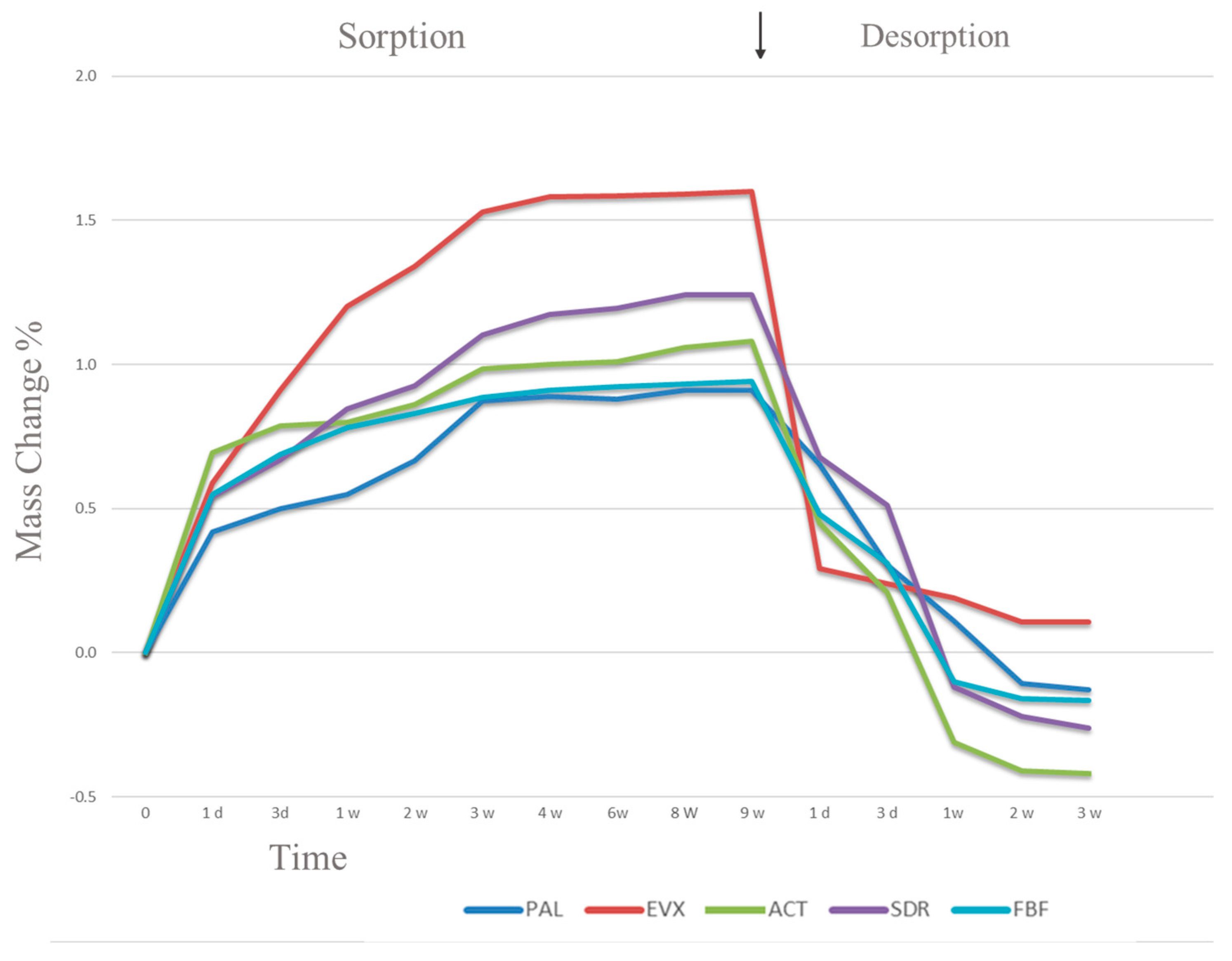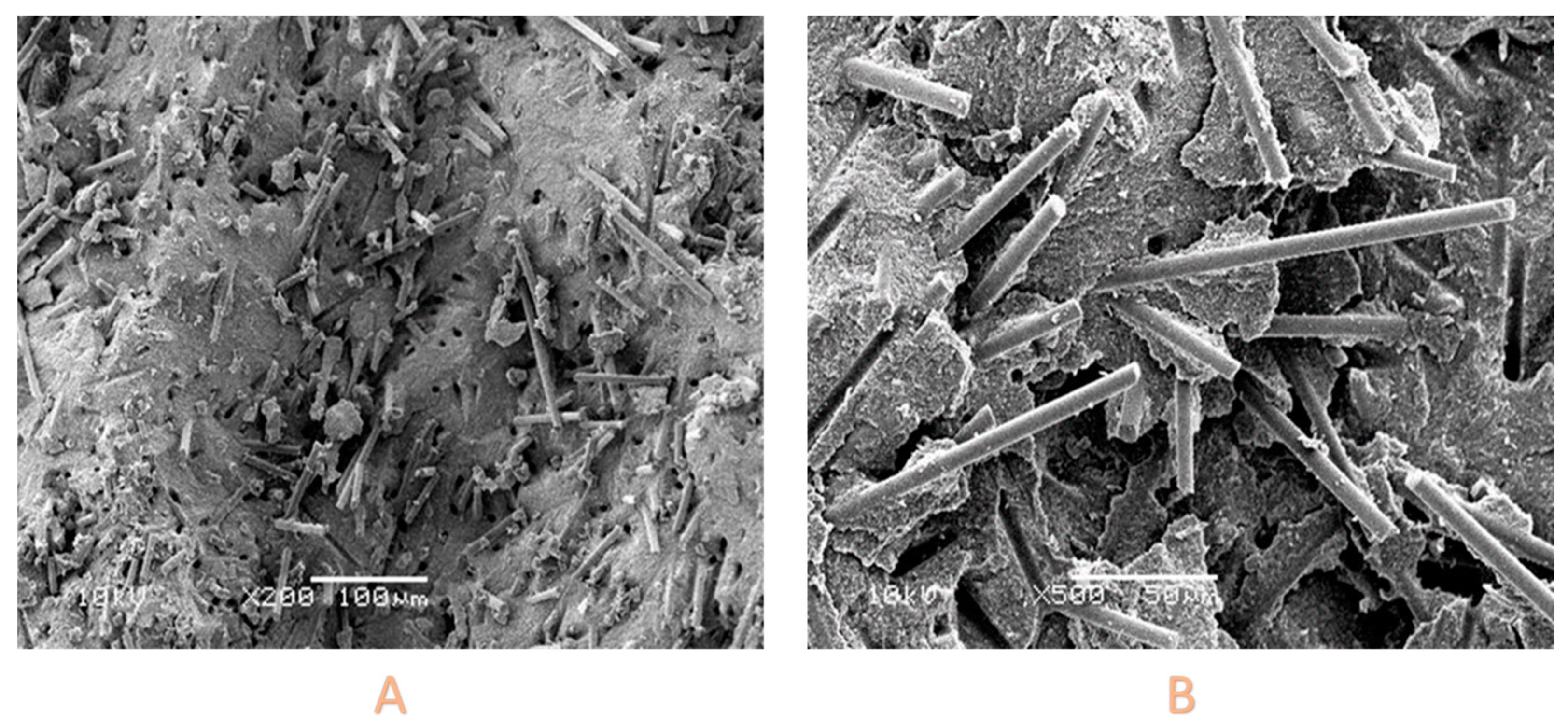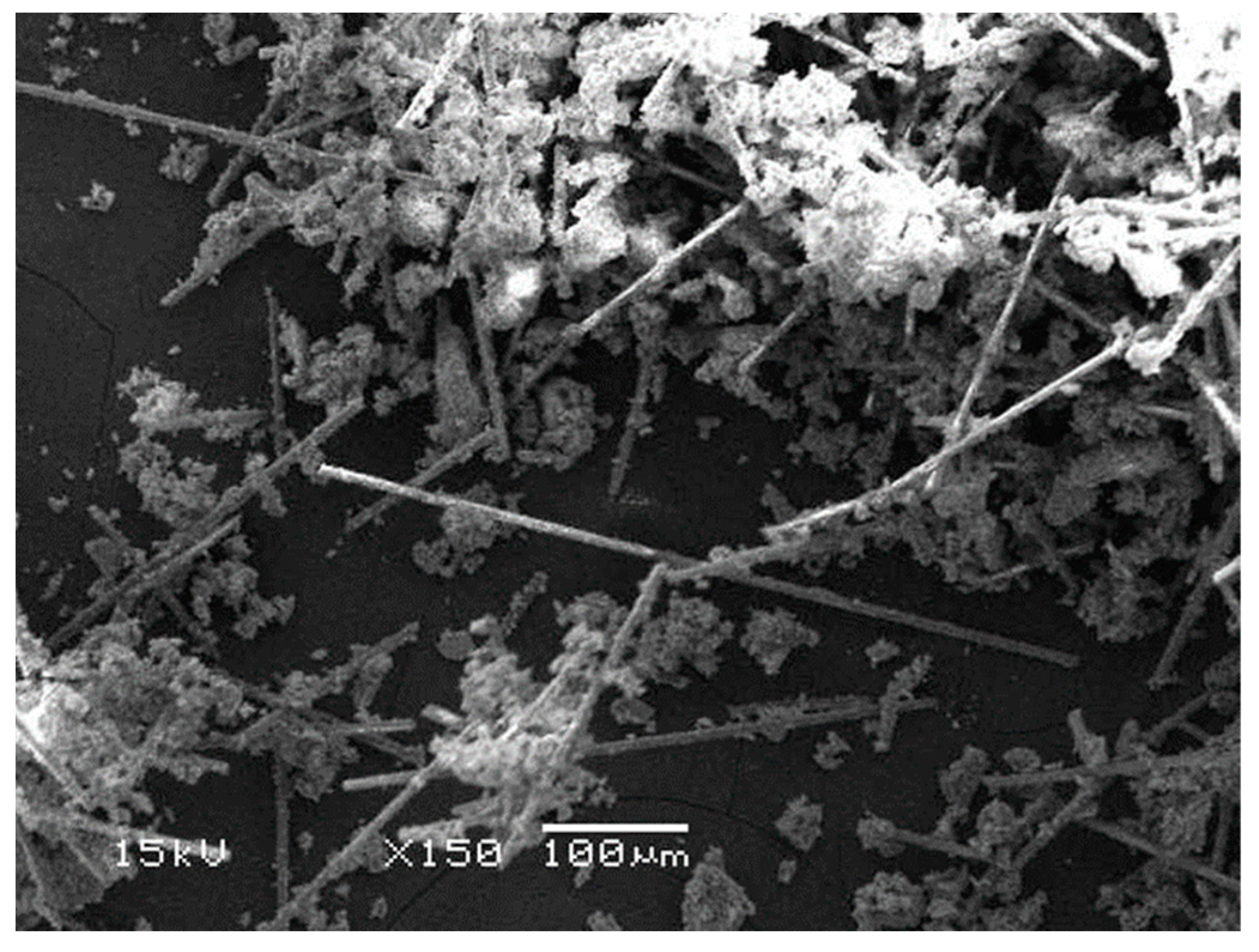Effect of Fibres on Physico-Mechanical Properties of Bulk-Fill Resin Composites
Abstract
1. Introduction
- There will be no difference in flexural strength among the materials.
- There will be no difference in flexural strength among the materials after 1 and 30 days of water storage at 37 °C.
- There will be no difference in water sorption or solubility after 140 days of water exposure.
2. Materials and Methods
2.1. Fibre Length Measurement
2.2. Flexural Strength and Modulus Measurement
2.3. Water Sorption and Solubility
2.3.1. Specimen Preparation
2.3.2. Sorption and Solubility Measurement
2.4. Statistical Analyses
3. Results
3.1. Fibre Length Measurement
3.2. Flexural Strength
3.3. Flexural Modulus
3.4. Water Sorption and Solubility
3.5. SEM Examination
4. Discussion
4.1. Flexural Strength
4.2. Sorption and Solubility
5. Conclusions
- The glass-fibre-reinforced resin composite (EVF) demonstrated the highest flexural strength (FS) among the tested materials, while SDR and ACT exhibited the lowest FS.
- The manufacturers recommend applying a conventional resin composite cap on EVF and SDR. The considerable decrease in FS observed in EVF and SDR following exposure to water supports this recommendation.
- While variations were apparent in the water sorption and desorption cycles of the resin-matrix composites investigated in the current study, all the tested materials complied with the ISO 4049 requirements for water solubility and sorption, irrespective of the length of the sorption period.
6. Clinical and Practical Significance
- The enhanced mechanical properties of EVF introduce possibilities for innovative dental restorations in situations demanding superior strength and durability.
- Insights into water exposure effects enrich the understanding of material behaviour in realistic oral conditions, guiding informed material selection and clinical practice.
Author Contributions
Funding
Institutional Review Board Statement
Informed Consent Statement
Data Availability Statement
Acknowledgments
Conflicts of Interest
References
- Ferracane, J.L. Resin composite—State of the art. Dent. Mater. 2011, 27, 29–38. [Google Scholar] [CrossRef] [PubMed]
- Braga, R.R.; Ferracane, J.L. Alternatives in polymerization contraction stress management. Crit. Rev. Oral Biol. Med. 2004, 15, 176–184. [Google Scholar] [CrossRef]
- Chesterman, J.; Jowett, A.; Gallacher, A.; Nixon, P. Bulk-fill resin-based composite restorative materials: A review. Br. Dent. J. 2017, 222, 337–344. [Google Scholar] [CrossRef] [PubMed]
- Veloso, S.R.M.; Lemos, C.A.A.; de Moraes, S.L.D.; do Egito Vasconcelos, B.C.; Pellizzer, E.P.; de Melo Monteiro, G.Q. Clinical performance of bulk-fill and conventional resin composite restorations in posterior teeth: A systematic review and meta-analysis. Clin. Oral Investig. 2019, 23, 221–233. [Google Scholar] [CrossRef] [PubMed]
- Arbildo-Vega, H.I.; Lapinska, B.; Panda, S.; Lamas-Lara, C.; Khan, A.S.; Lukomska-Szymanska, M. Clinical effectiveness of bulk-fill and conventional resin composite restorations: Systematic review and meta-analysis. Polymers 2020, 12, 1786. [Google Scholar] [CrossRef] [PubMed]
- Sarrett, D.C. Clinical challenges and the relevance of materials testing for posterior composite restorations. Dent. Mater. 2005, 21, 9–20. [Google Scholar] [CrossRef]
- Alshabib, A.; Silikas, N.; Watts, D.C. Hardness and fracture toughness of resin-composite materials with and without fibers. Dent. Mater. 2019, 35, 1194–1203. [Google Scholar] [CrossRef]
- Daabash, R.; Alqahtani, M.Q.; Price, R.B.; Alshabib, A.; Niazy, A.; Alshaafi, M.M. Surface Properties and Streptococcus mutans Biofilm Adhesion of Ion-Releasing Resin-Based Composite Materials. J. Dent. 2023, 134, 104549. [Google Scholar] [CrossRef]
- Alshabib, A.; Alshehri, A.; Jurado, C.A.; Alrahlah, A.; Almazrou, A.; Albuhayri, M.; Alnujaym, A.; Almuhanna, A.; Fischer, N.G.; Algamaiah, H. Mechanical Stability of Self-Adhesive/Ion-Releasing Resin Composites. Coatings 2023, 13, 201. [Google Scholar] [CrossRef]
- Alshabib, A.; Algamaiah, H.; Silikas, N.; Watts, D.C. Material behavior of resin composites with and without fibers after extended water storage. Dent. Mater. J. 2021, 40, 557–565. [Google Scholar] [CrossRef]
- Elliott, J.E.; Lovell, L.; Bowman, C. Primary cyclization in the polymerization of bis-GMA and TEGDMA: A modeling approach to understanding the cure of dental resins. Dent. Mater. 2001, 17, 221–229. [Google Scholar] [CrossRef]
- Lohbauer, U.; Belli, R.; Ferracane, J.L. Factors involved in mechanical fatigue degradation of dental resin composites. J. Dent. Res. 2013, 92, 584–591. [Google Scholar] [CrossRef] [PubMed]
- Martos, J.; Osinaga, P.W.R.; Oliveira, E.D.; Castro, L.A.S.D. Hydrolytic degradation of composite resins: Effects on the microhardness. Mater. Res. 2003, 6, 599–604. [Google Scholar] [CrossRef]
- Lee, S.; Huang, H.; Lin, C.; Shih, Y. Leached components from dental composites in oral simulating fluids and the resultant composite strengths. J. Oral Rehabil. 1998, 25, 575–588. [Google Scholar] [CrossRef] [PubMed]
- Drummond, J.L. Degradation, fatigue, and failure of resin dental composite materials. J. Dent. Res. 2008, 87, 710–719. [Google Scholar] [CrossRef] [PubMed]
- Barszczewska-Rybarek, I.M. A guide through the dental dimethacrylate polymer network structural characterization and interpretation of physico-mechanical properties. Materials 2019, 12, 4057. [Google Scholar] [CrossRef]
- Ferracane, J.; Berge, H.; Condon, J. In vitro aging of dental composites in water—Effect of degree of conversion, filler volume, and filler/matrix coupling. J. Biomed. Mater. Res. Off. J. Soc. Biomater. Jpn. Soc. Biomater. Aust. Soc. Biomater. 1998, 42, 465–472. [Google Scholar] [CrossRef]
- Algamaiah, H.; Danso, R.; Banas, J.; Armstrong, S.R.; Whang, K.; Rawls, H.R.; Teixeira, E.C. The effect of aging methods on the fracture toughness and physical stability of an oxirane/acrylate, ormocer, and Bis-GMA-based resin composites. Clin. Oral Investig. 2020, 24, 369–375. [Google Scholar] [CrossRef] [PubMed]
- Drummond, J.; Savers, E. In vitro aging of a heat/pressure-cured composite. Dent. Mater. 1993, 9, 214–216. [Google Scholar] [CrossRef]
- Janda, R.; Roulet, J.-F.; Latta, M. The effects of thermocycling on the flexural strength and flexural modulus of modern resin-based filling materials. Dent. Mater. 2006, 22, 1103–1108. [Google Scholar] [CrossRef]
- Tanaka, J.; Inoue, K.; Masamura, H.; Matsumura, K.; Nakai, H.; Inoue, K. The Application of Fluorinated Aromatic Dimethacrylates to Experimental Light-cured Radiopaque Composite Resin, Containing Barium-Borosilicate Glass Filler A Progress in Nonwaterdegradable Properties. Dent. Mater. J. 1993, 12, 1–11, 89. [Google Scholar] [CrossRef] [PubMed]
- ISO 4049:2019; Dentistry—Polymer-Based Restorative Materials. International Organization for Standardization: Geneva Switzerland, 2009.
- Abouelleil, H.; Pradelle, N.; Villat, C.; Attik, N.; Colon, P.; Grosgogeat, B. Comparison of mechanical properties of a new fiber reinforced composite and bulk filling composites. Restor. Dent. Endod. 2015, 40, 262–270. [Google Scholar] [CrossRef] [PubMed]
- Asmussen, E.; Peutzfeldt, A. Flexural strength and modulus of a step-cured resin composite. Acta Odontol. Scand. 2004, 62, 87–90. [Google Scholar] [CrossRef] [PubMed]
- Kakuta, K.; Urapepon, S.; Miyagawa, Y.; Ogura, H.; Yamanaka, M.; Suchatlampong, C.; Rittapai, A. Development of metal-resin composite restorative material. Part 4. Flexural strength and flexural modulus of metal-resin composite using Ag-In alloy particles as filler. Dent. Mater. J. 2002, 21, 181–190. [Google Scholar] [CrossRef][Green Version]
- Brunthaler, A.; König, F.; Lucas, T.; Sperr, W.; Schedle, A. Longevity of direct resin composite restorations in posterior teeth: A review. Clin. Oral Investig. 2003, 7, 63–70. [Google Scholar] [CrossRef]
- Heintze, S.D.; Rousson, V. Clinical effectiveness of direct class II restorations-a meta-analysis. J. Adhes. Dent. 2012, 14, 407–431. [Google Scholar]
- Ilie, N.; Hilton, T.; Heintze, S.; Hickel, R.; Watts, D.; Silikas, N.; Stansbury, J.; Cadenaro, M.; Ferracane, J. Academy of dental materials guidance—Resin composites: Part I—Mechanical properties. Dent. Mater. 2017, 33, 880–894. [Google Scholar] [CrossRef]
- Attik, N.; Colon, P.; Gauthier, R.; Chevalier, C.; Grosgogeat, B.; Abouelleil, H. Comparison of physical and biological properties of a flowable fiber reinforced and bulk filling composites. Dent. Mater. 2022, 38, e19–e30. [Google Scholar] [CrossRef]
- Lassila, L.; Keulemans, F.; Säilynoja, E.; Vallittu, P.K.; Garoushi, S. Mechanical properties and fracture behavior of flowable fiber reinforced composite restorations. Dent. Mater. 2018, 34, 598–606. [Google Scholar] [CrossRef] [PubMed]
- Lassila, L.; Keulemans, F.; Vallittu, P.K.; Garoushi, S. Characterization of restorative short-fiber reinforced dental composites. Dent. Mater. J. 2020, 39, 992–999. [Google Scholar] [CrossRef]
- Petersen, R. Discontinuous fiber-reinforced composites above critical length. J. Dent. Res. 2005, 84, 365–370. [Google Scholar] [CrossRef]
- Rodrigues Junior, S.A.; Zanchi, C.H.; Carvalho, R.V.D.; Demarco, F.F. Flexural strength and modulus of elasticity of different types of resin-based composites. Braz. Oral Res. 2007, 21, 16–21. [Google Scholar] [CrossRef] [PubMed]
- Alshehri, A.; Alhalabi, F.; Robaian, A.; Abuelqomsan, M.A.; Alshabib, A.; Ismail, E.; Alzamil, F.; Alotaibi, N.; Algamaiah, H. No-Cap Flowable Bulk-Fill Composite: Physico-Mechanical Assessment. Polymers 2023, 15, 1847. [Google Scholar] [CrossRef]
- Rüttermann, S.; Dluzhevskaya, I.; Großsteinbeck, C.; Raab, W.H.-M.; Janda, R. Impact of replacing Bis-GMA and TEGDMA by other commercially available monomers on the properties of resin-based composites. Dent. Mater. 2010, 26, 353–359. [Google Scholar] [CrossRef] [PubMed]
- Eweis, A.; Yap, A.; Yahya, N. Comparison of flexural properties of bulk-fill restorative/flowable composites and their conventional counterparts. Oper. Dent. 2020, 45, 41–51. [Google Scholar] [CrossRef]
- Shah, P.K.; Stansbury, J.W.; Bowman, C.N. Application of an addition–fragmentation-chain transfer monomer in di (meth) acrylate network formation to reduce polymerization shrinkage stress. Polym. Chem. 2017, 8, 4339–4351. [Google Scholar] [CrossRef] [PubMed]
- Hasanain, F.A.; Nassar, H.M.; Ajaj, R.A. Effect of light curing distance on microhardness profiles of bulk-fill resin composites. Polymers 2022, 14, 528. [Google Scholar] [CrossRef]
- Yeo, H.W.; Loo, M.Y.; Alkhabaz, M.; Li, K.C.; Choi, J.J.E.; Barazanchi, A. Bulk-fill direct restorative materials: An in vitro assessment of their physio-mechanical properties. Oral 2021, 1, 75–87. [Google Scholar] [CrossRef]
- Marghalani, H.Y.; Watts, D.C. Viscoelastic stability of resin-composites aged in food-simulating solvents. Dent. Mater. 2013, 29, 963–970. [Google Scholar] [CrossRef]
- Sideridou, I.D.; Karabela, M.M.; Vouvoudi, E.C.; Papanastasiou, G.E. Sorption and desorption parameters of water or ethanol in light-cured dental dimethacrylate resins. J. Appl. Polym. Sci. 2008, 107, 463–475. [Google Scholar] [CrossRef]
- Randolph, L.D.; Palin, W.M.; Leloup, G.; Leprince, J.G. Filler characteristics of modern dental resin composites and their influence on physico-mechanical properties. Dent. Mater. 2016, 32, 1586–1599. [Google Scholar] [CrossRef] [PubMed]
- Matinlinna, J.P.; Lung, C.Y.K.; Tsoi, J.K.H. Silane adhesion mechanism in dental applications and surface treatments: A review. Dent. Mater. 2018, 34, 13–28. [Google Scholar] [CrossRef] [PubMed]
- Al Sunbul, H.; Silikas, N.; Watts, D.C. Resin-based composites show similar kinetic profiles for dimensional change and recovery with solvent storage. Dent. Mater. 2015, 31, e201–e217. [Google Scholar] [CrossRef] [PubMed]
- Örtengren, U.; Wellendorf, H.; Karlsson, S.; Ruyter, I. Water sorption and solubility of dental composites and identification of monomers released in an aqueous environment. J. Oral Rehabil. 2001, 28, 1106–1115. [Google Scholar] [CrossRef]
- Creugers, N.; Kreulen, C.M.; Fokkinga, W.A.; Mentink, A. A 5-year prospective clinical study on core restorations without covering crowns. Int. J. Prosthodont. 2005, 18, 40–41. [Google Scholar]



| Material | Manufacturer | Type | Filler Load wt% | Filler Type | Resin Matrix | |
|---|---|---|---|---|---|---|
| Code | Name | |||||
| EVF | ever X Flow | GC Corporation, Tokyo, Japan | Flowable Fibre reinforced BulkFill | 70% | E-Glass short fibres, Barium Borosilicate Glass particulate | Bis-GMA, TEGDMA, Bis-EMA |
| ACT | Actvia | Pulpdent | Dual cure bulk fill | 55.4% | Reactive ionomer glass fillers and sodium fluoride | Patented ionic resin matrix, shock-absorbing rubberised resin (diurethane and other methacrylates with modified polyacrylic acid) |
| PAL | PALFIQUE Bulk Flow | Tokuyama Dental, Tokyo, Japan | Flowable bulk fill | 70% | Zirconia filler Silica fillers/ | Bis-GMA, TEGDMA, Bis-MPEPP, Mequinol, Dibutyl hydroxyl toluene |
| FBF | Filtek Bulk fill | 3M ESPE, St. Paul, MN, USA | Nano-hybrid Bulk fill A2 shade | 76.5% | ytterbium tytterbium trioride and zircon silica | DDDMA, UDMA, AUDMA |
| SDR | SDR Flow composite | Dentsply Sirona Charlotte, NC, USA | Bulk fill | 68% | Bari-um-alumino-fluoro-borosilicate glass and strontium alumino-fluoro-silicate glas | Modified UDMA, ethoxylated ethoxylated Bisphenol A dimethacrylate, and TEGDMA |
| Fibre Length | ||
|---|---|---|
| 200–400 µm | 400–811 µm | |
| Fibre lengths grouped by average length (mm) | 340 | 619 |
| Fibre lengths grouped by percentage values (%) | 68% | 32% |
| Material | Flexural Strength (MPa) | ||
|---|---|---|---|
| 1 Day | 30 Days | Change % | |
| EXF | 149.1 (8.1) Aa | 111.6 (5.4) Ab | −24 |
| PAL | 137.7 (12.0) A | 126.5 (9.3) B | −8 |
| FBF | 139.8 (9.3) A | 119.6 (10.1) B | −13 |
| SDR | 110.0 (7.1) Bc | 88.3 (7.2) Cd | −20 |
| ACT | 108.6 (10.4) B | 129.5 (9.6) B | +11 |
| Material | Flexural Modulus (GPa) | ||
|---|---|---|---|
| 1 Day | 30 Days | Change % | |
| EXF | 11.9 (1.4) Aa | 10.8 (1.1) Aa | −9 |
| PAL | 10.7 (0.9) Aa | 9.9 (1.0) Aa | −8 |
| FBF | 9.8 (0.8) Aa | 8.1 (0.3) Aa | −17 |
| SDR | 7.1 (0.2) Bb | 5.9 (0.5) Bc | −17 |
| ACT | 6.2 (0.3) Cd | 4.2 (0.8) Ce | −32 |
| Material | Sorption after 60 Days and Solubility after 21 Days | ||
|---|---|---|---|
| % Mass Change | Sorption | Solubility | |
| EXF | 1.60 (0.19) A | 26.9 (1.8) A | −0.88 (0.10) A |
| PAL | 0.91 (0.11) B | 18.4 (2.0) B | 2.8 (0.19) B |
| FBF | 1.12 (0.10) C | 21.89 (2.1) B | 3.1 (0.59) B |
| SDR | 1.24 (0.21) D | 28.11 (2.5) A | 3.2 (0.37) B |
| ACT | 1.08 (0.18) C | 29.2 (3.8) A | 5.8 (0.31) C |
Disclaimer/Publisher’s Note: The statements, opinions and data contained in all publications are solely those of the individual author(s) and contributor(s) and not of MDPI and/or the editor(s). MDPI and/or the editor(s) disclaim responsibility for any injury to people or property resulting from any ideas, methods, instructions or products referred to in the content. |
© 2023 by the authors. Licensee MDPI, Basel, Switzerland. This article is an open access article distributed under the terms and conditions of the Creative Commons Attribution (CC BY) license (https://creativecommons.org/licenses/by/4.0/).
Share and Cite
Alshabib, A.; Silikas, N.; Algamaiah, H.; Alayad, A.S.; Alawaji, R.; Almogbel, S.; Aldosari, A.; Alhotan, A. Effect of Fibres on Physico-Mechanical Properties of Bulk-Fill Resin Composites. Polymers 2023, 15, 3452. https://doi.org/10.3390/polym15163452
Alshabib A, Silikas N, Algamaiah H, Alayad AS, Alawaji R, Almogbel S, Aldosari A, Alhotan A. Effect of Fibres on Physico-Mechanical Properties of Bulk-Fill Resin Composites. Polymers. 2023; 15(16):3452. https://doi.org/10.3390/polym15163452
Chicago/Turabian StyleAlshabib, Abdulrahman, Nick Silikas, Hamad Algamaiah, Abdullah S. Alayad, Rahaf Alawaji, Shaikha Almogbel, Ahad Aldosari, and Abdulaziz Alhotan. 2023. "Effect of Fibres on Physico-Mechanical Properties of Bulk-Fill Resin Composites" Polymers 15, no. 16: 3452. https://doi.org/10.3390/polym15163452
APA StyleAlshabib, A., Silikas, N., Algamaiah, H., Alayad, A. S., Alawaji, R., Almogbel, S., Aldosari, A., & Alhotan, A. (2023). Effect of Fibres on Physico-Mechanical Properties of Bulk-Fill Resin Composites. Polymers, 15(16), 3452. https://doi.org/10.3390/polym15163452







